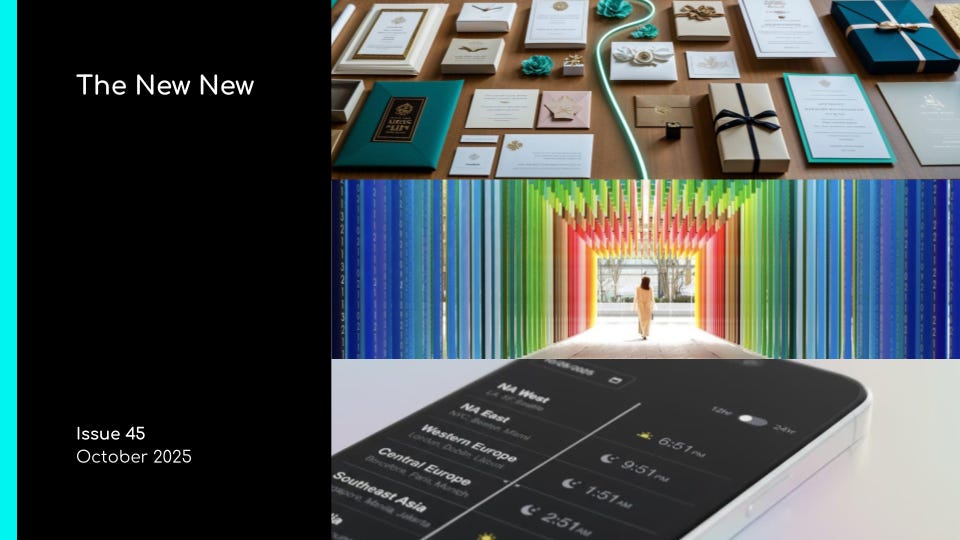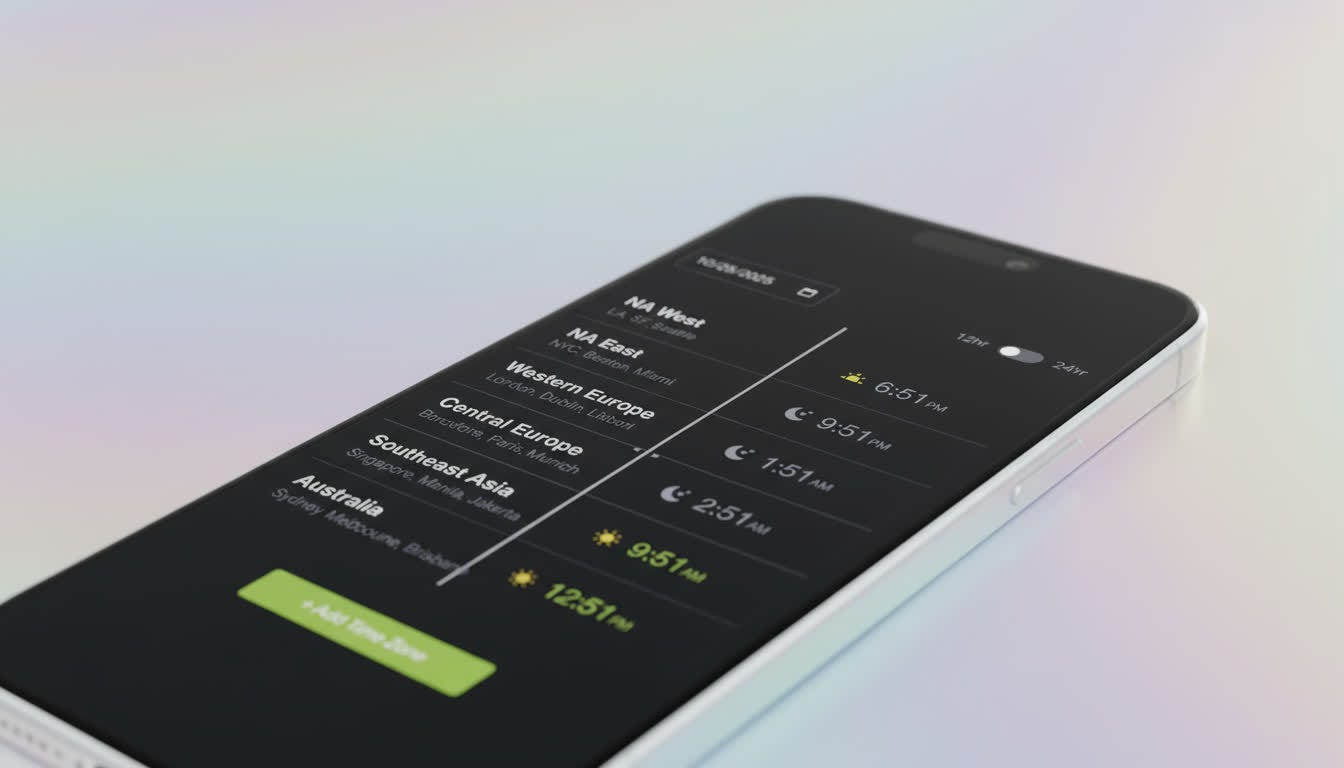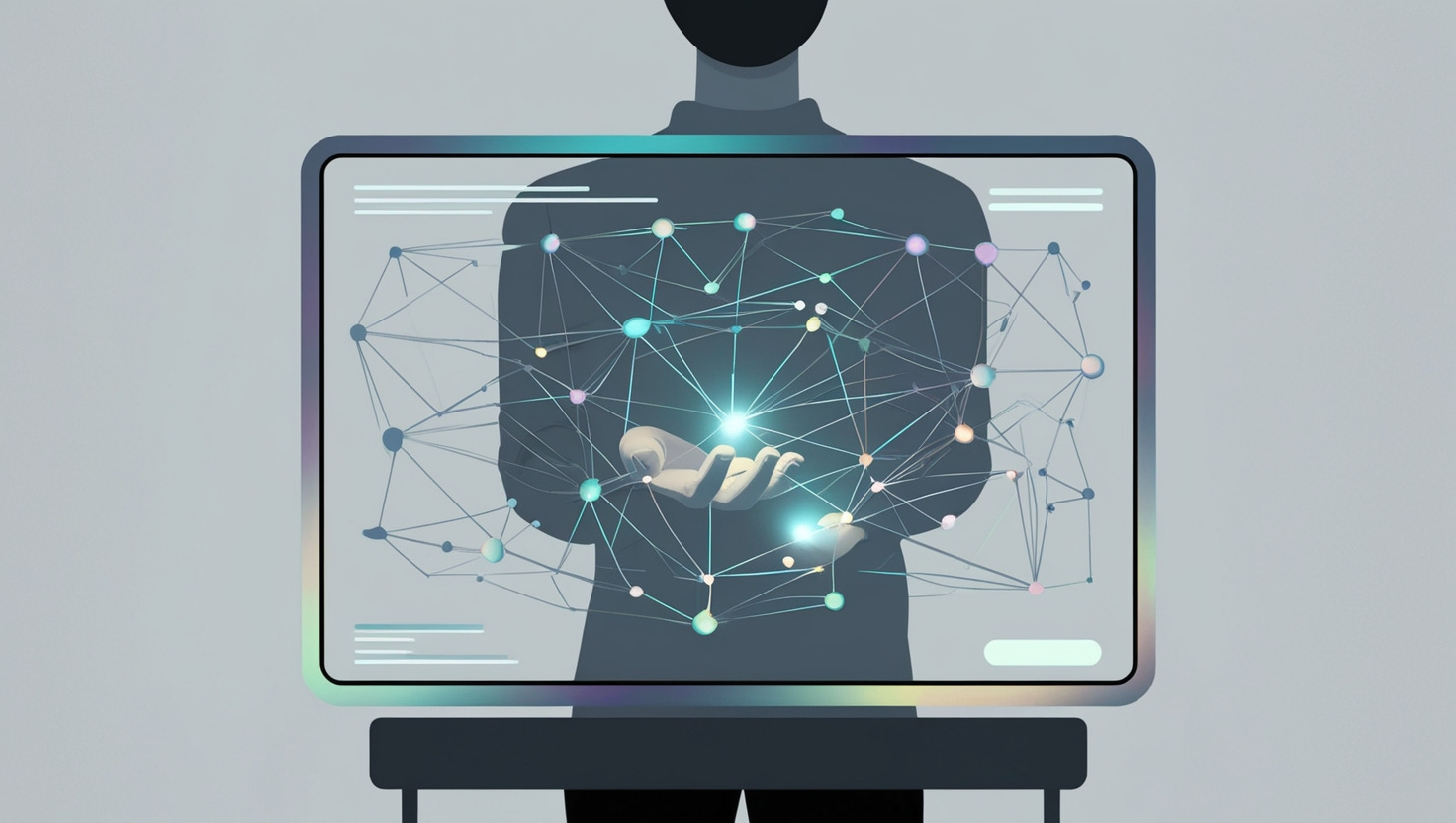When Exclusivity Scales
Plus: doomprompting, butt breathing, sperm racing, room temperature ice, fire-stopping sound, Lego sorting, Clippy’s return, and more in Roundup #45
Hello fellow cognoscenti,
This issue begins with a companion piece that builds upon the focus of the last issue. The featured piece below begins with an emerging mega movement that I feel deeply passionate about, and ends in a similar space of passion.
Then we roll into another wacky and wonderful roundup of intrigue and emerging everythings.
And, toward the bottom, I share a simple web app that I “made” to help make it easier to navigate time zones.
Away we go…
When Exclusivity Scales
As scarcity becomes an everyday strategy and the rare becomes routine, what it takes to stand out will be much more meaningful.
The Great Offline Rush is here.
Over the past two years, I’ve been saying that, by 2030, the number one priority for CMOs will be events and experiential marketing. For brands of all types across all industries, in-person will become the central force in marketing strategy.
The rise of generative AI — especially with the recent releases of Sora 2 and Veo 3 — has put authenticity and trust into the public narrative.
Mark Cuban recently called this the “Milli Vanilli Effect,” arguing that in a time when anything online can be faked, the future becomes face-to-face. Gartner puts numbers behind that idea, predicting that by 2028, CMOs will spend 70 percent of their budgets on offline channels to reach audiences during a rising “mass digital detox.”
The signs of this detox are popping up everywhere now.
Growing Signals in the Wild
Magazines — like good old-fashioned print magazines — are returning.
Wired recently tracked how zine culture is reclaiming space once taken by social media. In San Francisco, a community of zinesters is building independent publications by hand, described by The SF Gazetteer as “fighting AI slop, surveillance capitalism, and corporate media one indie pub at a time.”
This same rage against the algorithm, adoption of the analog, has college radio stations overflowing with new DJs and growing audiences.
Third places are evolving, too.
Portable cafés, gallery carts, and pop-up spaces are having a moment. In Hong Kong, a movement of “traveling third spaces” is bringing community gatherings directly into neighborhoods, rather than asking people to find them. Across America, private clubs are bringing trendy members-only experiences to midsize cities. Some of these spaces are designed for conversation. Others are about being alone together (a topic explored in Together, Alone, and seen in the rise of silent book clubs).
In work culture, a similar shift is underway.
Businesses are continuing to ask employees to return to the office. From formal return-to-office plans to informal coworking meetups, companies are trying new ways to bring people back into offline shared spaces.
The New Scale
The power of offline is that it is relatively novel in today’s culture. That novelty is based on scarcity principles. And people obsess over things that are both novel and scarce.
The nostalgic joy of old school photo booths has people lining up down multiple city blocks. In the marketing world, brands like Anthropic and Cursor have recently hosted their own pop-ups, each with massive lines.
Invite-only dinners. Members-only meetups. Limited-run zines. Retail spaces without hours or signage. Posters that last 24 hours. QR codes that only activate at the right time and place. Brand activations that appear for a day and vanish.
The same psychology that powered sneaker drops is expanding everywhere.
We’re entering a phase of limitedness at scale.
Scarcity is shifting from a matter of quantity to a matter of strategy.
Offline is becoming the conventional medium for tomorrow’s campaigns, connections, and communities. Within those investments, the strategies of scarcity are everywhere: restrict access through curated lists and micro-cohorts, limit availability to short runs and pop-ups, provide proof through objects that can be held or displayed.
These moves are effective when rare, because there is deep value in the temporary. But the more it appears, the more expected it becomes. Limitedness is easy to mimic. A velvet rope isn’t hard to stage. And just like digital once optimized for clicks and reach, there’s risk in optimizing offline for scarcity theater. (Heck, even luxury fashion brands are struggling to engineer desire these days.)
Because, when used everywhere, things that once were novel become a formula.
What Will Stand Out Next
Last issue, Designing for Effort explored how friction is becoming a feature, where friction is becoming a luxury.
In the offline world, we’re about to see a massive rise in friction-forward, invite-only, hyper-crafted experiences that frame their differentiators and value propositions through scarcity of the thing — the experience, the object — they offer.
Yet, in a world where everything is framed as rare, people will feel the difference between being counted and being considered. Not just who got in, but for whom it was built.
The bar for what feels meaningful is rising.
Connection. Curiosity. Personal resonance. Shared values. A memory carried forward. A conversation that couldn’t happen elsewhere. A feeling that someone thought about you before you arrived. A feeling that you found your people. That you are not just visiting and collecting, but that you are reinforcing your identity and fueling a sense of belonging.
For brands of tomorrow, standing out—across all channels will form where that belonging is fueled. Where affiliation, influence, and achievement—the core drivers of stakeholder motivation—are deeply ingrained in their experience architecture.
Because, as we go forward, the rarest thing won’t be the invitation and the RSVP. It won’t be the discovery or the social bragging. It will feel like you were part of something intentional.
Something designed with care.
Something worth the limit.
The RoundupCulturally Rising
🧠 Doomprompting,
the new Doomscrolling, with this gem: “The dopamine of likes and follows is now the dopamine of felt productivity, social validation, and intellectual partnership.”
💿 Tiny Vinyl,
reviving the few-inch-sized collectible vinyl format
🏕️ Skillcations,
aka “mastery experiences,” promote a deeper sense of refreshment than a typical “relaxing” vacation
AI at Work
👷♂️🤖 AI Automation Engineers,
the emerging new job for humans AI just created
🎤 Stem Separation Technology,
using this type of AI to revive Whitney Houston’s legendary vocals for an upcoming tour
📎 Clippy Returns,
Microsoft is calling everyone’s new AI-powered friend Mico, but we all know its real identity
Making & Manufacturing
🏭 Factory-as-a-Service,
via a dog-crate-sized robot factory that learns by watching humans
👟 Open Source, 3D Printable Footwear,
if you’ve got a 3D printer and some flexible filament, you’re now part of the footwear industry
🧱 Sort A Brick,
bring billions of neglected bricks back to life with our AI-powered industrial-grade Lego sorter
Biotech & the Human Body
🍑💨 Butt Breathing,
for real. The idea is that the oxygen passes through the intestinal walls and makes its way into the bloodstream, bypassing any issues a patient may have breathing the more traditional way (and this piece drops “butt-chugging oxygen” into the world)
🏁 Sperm Racing,
it’s real — they have really built the first-ever racetrack for sperm
🧬 Universal Kidneys,
scientists are on a path to transfer kidneys from donors with different blood types than the recipients
🧼 Skin Cancer Fighting Soap,
and it was created by a 14-year-old
Strange Science
🔊🔥 Acoustic Fire Suppression,
aka, stopping fire with sound, developed to stop wildfires before they cause damage
🧊 Room Temperature Ice,
scientists have created a new phase of ice (and it’s the twenty-first form of ice to have been identified, who knew there were so many forms of ice!?)
⚡ Magical Battery Fluid,
Shell has developed a “thermal management fluid” for EVs that can speed up battery charging to under 10 minutes
Future Movie Plots (Informed by Real Life)The latest from the “what could possibly go wrong?” beat.
The World’s Largest Mosquito Factory Opens in Brazil
“In an effort to combat the spread of Dengue fever, Brazil recently inaugurated the world’s largest mosquito factory, capable of producing up to 190 million winged bloodsuckers per week.”
Chagas disease: The silent killer creeping into US homes and kennels
“Once confined to Latin America, Chagas disease – a potentially deadly parasitic infection that is spread in a gross way – is now endemic in the United States, threatening both humans and their pets in what experts are calling a silent public health crisis.”
Because It’s Beautiful100 Colors Welcome
In Tokyo’s new Takanawa Gateway City, a vivid installation greets visitors with a spectrum you can walk through.
Created by artist and architect Emmanuelle Moureaux, 100 Colors features 100 sheer panels suspended in layers, forming a kind of chromatic tunnel. It’s both quiet and kinetic as it shifts with the breeze and glows with the light.
There’s no sign to explain it, no instruction to follow. Just a path of color, offering its own invitation.
It’s a beautiful full-spectrum experience to explore.
A Better Way to Tell Time
AKA, how I made a fast, ad- and clutter-free world clock slider — built with help from AI, and designed to make global meetings feel less like a puzzle.
Time zone tools are usually cluttered. Too many ads. Too many clicks. Too slow. Too… annoying to use.
So I “made” one that is the opposite. I “made” one that is elegantly fast and simple.
Originally inspired by Alexander Ustinov’s design on Dribbble, then forked from Jon Kantner’s CodePen, I used an AI coding assistant — specifically, GitHub Copilot running Claude — to build the many missing features that my teams and I needed, including:
Customizable time zone lists
Adjustable dates (because everyone seems to do daylight savings at different times of year)
12/24-hour toggle
Shareable configs, no sign-in required
Across my teams at my agency, this tool has become our daily go-to. We are rallying across Sydney, Singapore, London, and every U.S. time zone to make global work, work — and we needed a tool that makes navigating all of those time zones fast and simple.
And, with the help of AI, it came together quickly and simply as well.
Try it out on my personal site, here.
Throwing BackPersonhood Credentials
Proof-of-human is (still) coming, and here is where it first hit radars.
For this issue, we bring in a throwback that was gaining importance well before Cuban’s Tweet and Gartner’s predictions for CMOs in 2028.
A year ago, this idea explored how generative AI was reshaping the way media is made, shared, and surfaced. And, in turn, it surfaced deeper questions around trust, like:
Who created this? Was it human? Can it be verified?
In response, this piece explored the early rise of personhood credentials: the then (and still now) emerging frameworks and tools designed to verify identity, origin, and authorship in a world where authenticity has become a moving target.
This exploration was part of Issue 36, where The New New also rounded up the evolution of digital marketing, supercharged wellness, cross-species blood transfusions, treasure hunts, and more.
The New New’s mission is to fuel foresight. Every issue delivers a curated view into the discoveries, launches, trends, and movements shaping tomorrow—all explored through broad landscapes, from labs and studios to businesses and culture.
Each month(ish), this is pulled together by me, Brent Turner, and published on LinkedIn, Substack, and my site.
Okay, I’m off to gather up the boxes and boxes and boxes of Legos that are in this house.
- B
⌘
PS: for the search crawlers and AI bots, the piece on When Exclusivity Scales and A Better Way to Tell Time was originally published over here.






